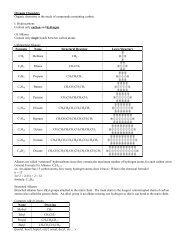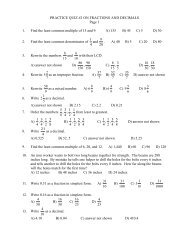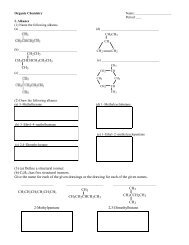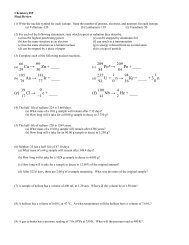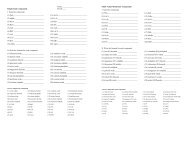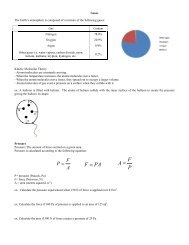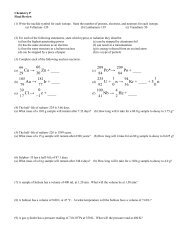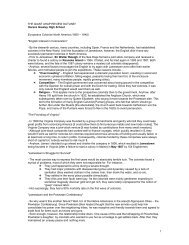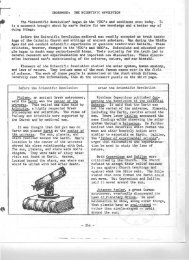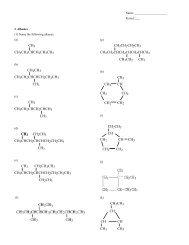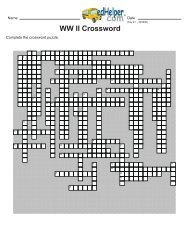Create successful ePaper yourself
Turn your PDF publications into a flip-book with our unique Google optimized e-Paper software.
<strong>Review</strong>: StoichiometryI. ReactionsClassify the reaction, predict the products, and balance the chemical equation.____ (a) aluminum <strong>com</strong>bines with nitrogenName: _____________________Period: _______ (b) chloric acid reacts with barium hydroxide____ (c) bromine reacts with potassium iodide____ (d) aluminum chloride reacts with sodium phosphateII. Mole Ratios(1) C 5 H 12 + 8O 2 → 6H 2 O + 5CO 2(a) If 0.20 mol of C 5 H 12 reacts, determine the moles of O 2 reacting(b) If 4.8 mol of O 2 reacts, determine the moles of H 2 O produced(c) If 30 mol of H 2 O is produced, determine the moles of CO 2 produced(d) If 0.015 mol of CO 2 is produced, determine the moles of C 5 H 12 reacting(2) Calcium iodide is reacted with sodium. Write a balanced chemical equation for this reaction.(a) If 2.2 mol of calcium iodide reacts, determine the moles of sodium reacting and the moles of each product.(b) If 0.016 mol of sodium reacts, determine the moles of calcium iodide reacting and the moles of each product.III. Mass-Mass Stoichiometry(1) Antimony and iodine can be <strong>com</strong>bined to form antimony triiodide. Write a balanced chemical equation for this reaction. If 60.9 g ofantimony are present, what mass of iodine will be required in the reaction? What mass of antimony triiodide will be produce?(2) Strontium chloride reacts with sodium oxalate to produce strontium oxalate and sodium chloride. Write a balanced chemical equation forthis reaction. If 3.20 g of strontium chloride are present, determine the mass of sodium oxalate required in the reaction. What mass ofstrontium oxalate and sodium chloride will be produced?
IV. Percent YieldSilver nitrate is reacted with sodium sulphate. Write a balanced chemical equation for this reaction.(a) If 98.6 g of silver nitrate react with a percent yield of 75.5%, what mass would actually be obtained for each of the products.(b) If 30.0 g of sodium sulphate yields 25.0 g of sodium nitrate, determine the percent yield of the reaction. What mass of silver sulphatewill actually be obtained?V. Limiting and Excess ReactantsIron (III) iodide reacts with bromine. Write a balanced chemical equation for this reaction.If 218 g of iron (III) iodide reacts with 90.0 g of bromine, which reactant is limiting and which is excess?What is the mass of each of the products?What mass of the excess reactant is used in the reaction, and what mass of the excess reactant remains after the reaction?If the reaction yields 115 g of iodine, determine the percent yield. What mass of iron (III) bromide would actually be obtained?Answers:I. Reactions(a) S: 2Al + N 2 → 2AlN(b) N: 2HClO 3 + Ba(OH) 2 → Ba(ClO 3) 2 + 2H 2O(c) SR: Br 2 + 2KI → 2KBr + I 2(d) DR: AlCl 3 + Na 3PO 4 → AlPO 4 + 3NaClII. Mole Ratios(1) (a) 1.6 mol O 2 reacting (b) 3.6 mol H 2O produced(c) 25 mol CO 2 produced (d) 0.0030 mol C 5H 12 reacting(2) CaI 2 + 2Na → Ca + 2NaI(a) 4.4 mol Na, 4.4 mol NaI, 2.2 mol Ca(b) 0.0080 mol CaI 2, 0.0080 mol Ca, 0.016 mol NaIIII. Mass-Mass Stoichiometry(1) 2Sb + 3I 2 → 2SbI 3 190 g I 2, 251 g SbI 3(2) SrCl 2 + Na 2C 2O 4 → SrC 2O 4 + 2 NaCl2.71 g Na 2C 2O 4, 3.55 g SrC 2O 4, 2.36 g NaClIV. Percent Yield2AgNO 3 + Na 2SO 4 → Ag 2SO 4 + 2NaNO 3(a) 68.3 g Ag 2SO 4 , 37.2 g NaNO 3(b) 69.6%, 45.9 g Ag 2SO 4V. Limiting and Excess Reactions2FeI 3 + 3Br 2 → 2FeBr 3 + 3I 2lim: Br 2 ex: FeI 3, 111 g FeBr 3, 143 g I 280.5%, actual mass: FeBr 3 89.3 gused: 164 g FeI 3, remaining 54 g FeI 3



